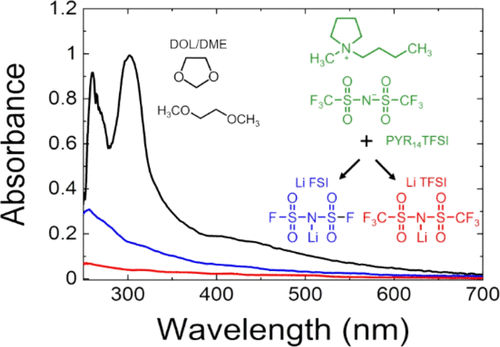当前位置:
X-MOL 学术
›
J. Phys. Chem. C
›
论文详情
Our official English website, www.x-mol.net, welcomes your
feedback! (Note: you will need to create a separate account there.)
In Situ UV–Vis Analysis of Polysulfide Shuttling in Ionic Liquid-Based Li-FeS2 Batteries
The Journal of Physical Chemistry C ( IF 3.3 ) Pub Date : 2022-03-15 , DOI: 10.1021/acs.jpcc.1c10074 Aliya S. Lapp 1 , Grace Whang 2 , Austin Bhandarkar 1 , Igor V. Kolesnichenko 3 , Bruce S. Dunn 2 , Timothy N. Lambert 3 , A. Alec Talin 1
The Journal of Physical Chemistry C ( IF 3.3 ) Pub Date : 2022-03-15 , DOI: 10.1021/acs.jpcc.1c10074 Aliya S. Lapp 1 , Grace Whang 2 , Austin Bhandarkar 1 , Igor V. Kolesnichenko 3 , Bruce S. Dunn 2 , Timothy N. Lambert 3 , A. Alec Talin 1
Affiliation

|
Herein, a combination of in situ and ex situ UV–Vis spectroscopy is used to study the formation and shuttling of polysulfides (PSs) in Li-FeS2 batteries. We find three key results. First, PS shuttling significantly decreases (∼4×) when an ionic liquid electrolyte (1.0 M LiFSI in PYR14TFSI; ILE) is used in place of a conventional organic electrolyte (1.0 M LiTFSI in 1:1 DOL:DME). Furthermore, when the Li salt anion in the ILE is changed from FSI– to TFSI–, PS shuttling is effectively suppressed. Second, the total amount of PSs formed using the ILE is approximately double the amount shuttled. This result has implications for battery aging as solubility of PSs could conceivably increase upon extended storage. Third, the majority of PS shuttling occurs during the first cycle. Together, these findings provide important insights for understanding and thus preventing PS shuttling in Li-FeS2 batteries.
中文翻译:

离子液体基 Li-FeS2 电池中多硫化物穿梭的原位 UV-Vis 分析
在此,结合原位和非原位 UV-Vis 光谱来研究 Li-FeS 2电池中多硫化物 (PSs) 的形成和穿梭。我们发现了三个关键结果。首先,当使用离子液体电解质(PYR 14 TFSI 中的 1.0 M LiFSI;ILE)代替传统的有机电解质(1:1 DOL:DME 中的 1.0 M LiTFSI )时,PS 穿梭显着降低(~4 倍)。此外,当 ILE 中的锂盐阴离子从 FSI –变为 TFSI –,PS穿梭得到有效抑制。其次,使用 ILE 形成的 PS 总量大约是穿梭数量的两倍。这一结果对电池老化有影响,因为 PS 的溶解度可能会在延长储存后增加。第三,大部分 PS 穿梭发生在第一个循环期间。总之,这些发现为理解和防止 PS 在 Li-FeS 2电池中穿梭提供了重要的见解。
更新日期:2022-03-15
中文翻译:

离子液体基 Li-FeS2 电池中多硫化物穿梭的原位 UV-Vis 分析
在此,结合原位和非原位 UV-Vis 光谱来研究 Li-FeS 2电池中多硫化物 (PSs) 的形成和穿梭。我们发现了三个关键结果。首先,当使用离子液体电解质(PYR 14 TFSI 中的 1.0 M LiFSI;ILE)代替传统的有机电解质(1:1 DOL:DME 中的 1.0 M LiTFSI )时,PS 穿梭显着降低(~4 倍)。此外,当 ILE 中的锂盐阴离子从 FSI –变为 TFSI –,PS穿梭得到有效抑制。其次,使用 ILE 形成的 PS 总量大约是穿梭数量的两倍。这一结果对电池老化有影响,因为 PS 的溶解度可能会在延长储存后增加。第三,大部分 PS 穿梭发生在第一个循环期间。总之,这些发现为理解和防止 PS 在 Li-FeS 2电池中穿梭提供了重要的见解。





















































 京公网安备 11010802027423号
京公网安备 11010802027423号